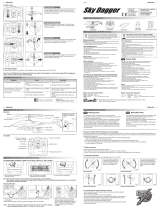
Warranty
Warranty Period
Exclusive Warranty- Horizon Hobby, Inc., (Horizon) warranties that the Products
purchased (the “Product”) will be free from defects in materials and workmanship at
the date of purchase by the Purchaser.
Limited Warranty
Horizon reserves the right to change or modify this warranty without notice
and disclaims all other warranties, express or implied.
(a) This warranty is limited to the original Purchaser (“Purchaser”) and is not
transferable. REPAIR OR REPLACEMENT AS PROVIDED UNDER THIS WARRANTY IS
THE EXCLUSIVE REMEDY OF THE PURCHASER. This warranty covers only those
Products purchased from an authorized Horizon dealer. Third party transactions are
not covered by this warranty. Proof of purchase is required for warranty claims.
Further, Horizon reserves the right to change or modify this warranty without notice
and disclaims all other warranties, express or implied.
(b) Limitations- HORIZON MAKES NO WARRANTY OR REPRESENTATION, EXPRESS
OR IMPLIED, ABOUT NON-INFRINGEMENT, MERCHANTABILITY OR FITNESS FOR A
PARTICULAR PURPOSE OF THE PRODUCT. THE PURCHASER ACKNOWLEDGES THAT
THEY ALONE HAVE DETERMINED THAT THE PRODUCT WILL SUITABLY MEET THE
REQUIREMENTS OF THE PURCHASER’S INTENDED USE.
(c) Purchaser Remedy- Horizon’s sole obligation hereunder shall be that Horizon will,
at its option, (i) repair or (ii) replace, any Product determined by Horizon to be
defective. In the event of a defect, these are the Purchaser’s exclusive remedies.
Horizon reserves the right to inspect any and all equipment involved in a warranty
claim. Repair or replacement decisions are at the sole discretion of Horizon. This
warranty does not cover cosmetic damage or damage due to acts of God, accident,
misuse, abuse, negligence, commercial use, or modification of or to any part of the
Product. This warranty does not cover damage due to improper installation,
operation, maintenance, or attempted repair by anyone other than Horizon. Return of
any goods by Purchaser must be approved in writing by Horizon before shipment.
Damage Limits
HORIZON SHALL NOT BE LIABLE FOR SPECIAL, INDIRECT OR CONSEQUENTIAL
DAMAGES, LOSS OF PROFITS OR PRODUCTION OR COMMERCIAL LOSS IN ANY WAY
CONNECTED WITH THE PRODUCT, WHETHER SUCH CLAIM IS BASED IN CONTRACT,
WARRANTY, NEGLIGENCE, OR STRICT LIABILITY. Further, in no event shall the
liability of Horizon exceed the individual price of the Product on which liability is
asserted. As Horizon has no control over use, setup, final assembly, modification or
misuse, no liability shall be assumed nor accepted for any resulting damage or injury.
By the act of use, setup or assembly, the user accepts all resulting liability.
If you as the Purchaser or user are not prepared to accept the liability associated with
the use of this Product, you are advised to return this Product immediately in new and
unused condition to the place of purchase.
Law: These Terms are governed by Illinois law (without regard to conflict of law
principals).
Safety Precautions
This is a sophisticated hobby Product and not a toy. It must be operated with caution
and common sense and requires some basic mechanical ability. Failure to operate
this Product in a safe and responsible manner could result in injury or damage to the
Product or other property. This Product is not intended for use by children without
direct adult supervision. The Product manual contains instructions for safety,
operation and maintenance. It is essential to read and follow all the instructions and
warnings in the manual, prior to assembly, setup or use, in order to operate correctly
and avoid damage or injury.
Questions, Assistance, and Repairs
Your local hobby store and/or place of purchase cannot provide warranty support
or repair. Once assembly, setup or use of the Product has been started, you must
contact Horizon directly. This will enable Horizon to better answer your questions
and service you in the event that you may need any assistance. For questions or
assistance, please direct your email to productsupport@horizonhobby.com, or call
877.504.0233 toll free to speak to a Product Support representative.
Inspection or Repairs
If this Product needs to be inspected or repaired, please call for a Return Merchan-
dise Authorization (RMA). Pack the Product securely using a shipping carton. Please
note that original boxes may be included, but are not designed to withstand the rigors
of shipping without additional protection. Ship via a carrier that provides tracking and
insurance for lost or damaged parcels, as Horizon is not responsible for merchandise
until it arrives and is accepted at our facility. A Service Repair Request is available
at www.horizonhobby.com on the “Support” tab. If you do not have internet access,
please include a letter with your complete name, street address, email address and
phone number where you can be reached during business days, your RMA number,
a list of the included items, method of payment for any non-warranty expenses and a
brief summary of the problem. Your original sales receipt must also be included for
warranty consideration. Be sure your name, address, and RMA number are clearly
written on the outside of the shipping carton.
Warranty Inspection and Repairs
To receive warranty service, you must include your original sales receipt verifying the
proof-of-purchase date. Provided warranty conditions have been met, your Product
will be repaired or replaced free of charge. Repair or replacement decisions are at the
sole discretion of Horizon Hobby.
Non-Warranty Repairs
Should your repair not be covered by warranty the repair will be completed and
payment will be required without notification or estimate of the expense unless the
expense exceeds 50% of the retail purchase cost. By submitting the item for repair
you are agreeing to payment of the repair without notification. Repair estimates are
available upon request. You must include this request with your repair. Non-warranty
repair estimates will be billed a minimum of ½ hour of labor. In addition you will be




















